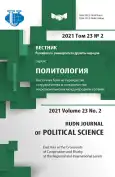Internationalization of Renminbi as a Function of China’s Foreign Exchange Policy
- Авторлар: Chernilevskaya K.E.1
-
Мекемелер:
- National Research University Higher School of Economics
- Шығарылым: Том 23, № 2 (2021): East Asia at the Crossroads of Cooperation and Rivalry at the Regional and International Levels
- Беттер: 233-242
- Бөлім: THE RISE OF CHINA: FOREIGN POLICY AND DOMESTIC DEVELOPMENT
- URL: https://journal-vniispk.ru/2313-1438/article/view/322119
- DOI: https://doi.org/10.22363/2313-1438-2021-23-2-233-242
- ID: 322119
Дәйексөз келтіру
Толық мәтін
Аннотация
This article discusses the prospects of the Chinese renminbi (RMB) to expand its sphere of influence and become a full-scale reserve world currency. The methods used in the article are retrospective analysis and graphic analysis. The work is divided into three sections. The first section provides a broad overview of modern reserve currencies. The second part characterizes RMB’s shaping as a reserve currency, as well as inner and outer factors that influence its status. The third section includes information about RMB’s current status and its perspectives for being a reserve currency in the future. The article argues that currently RMB has already become a regional reserve currency in Asia-Pacific. Chinese government continues to make steps towards international expansion of RMB, yet these steps cannot make RMB one of the leading world currencies together with USD and EUR in the nearest decade.
Негізгі сөздер
Авторлар туралы
Klavdiya Chernilevskaya
National Research University Higher School of Economics
Хат алмасуға жауапты Автор.
Email: kechernilevskaya@edu.hse.ru
ORCID iD: 0000-0002-7541-8888
MA Student, Faculty of World Economy and International Affairs
Moscow, Russian FederationӘдебиет тізімі
- Aglietta, M. (2011). Internalization of the Chinese currency. China Perspectives, 3(87), 79-83.
- Bowles, P., & Wang, B. (2013). Renminbi internationalization: A journey to where? Development and Change, 44(6), 1363-1385. DOI: dech.12058
- Carbaugh, R.J., & David W.H. (2009). Will the dollar be dethroned as the main reserve currency? Global Economy Journal, 9(3), 1. doi: 10.2202/1524-5861.1541
- Hyoung-kyu, C. (2013). Can the Renminbi rise as a global currency? The political economy of currency internationalization. Asian Survey, 53(2), 348-368.
- Jacques, M. (2009). When China rules the world: The rise of the middle kingdom and the end of the western world. London, UK: Allen Lane.
- Kuteleva, A., & Vasiliev, D. (2020). China’s belt and road initiative in Russian media: politics of narratives, images, and metaphors. Eurasian Geography and Economics, 61(6), 1-25. DOI: 15387216.2020.1833228
- Kurien, J., & Geoxavier, B.Y. (2020). The Political Economy of International Finance: A Revised Roadmap for Renminbi Internationalization. Yale Journal of International Affairs. Retrieved April 05, 2021, from https://www.yalejournal.org/publications/the-political-economy-of-international-finance-a-revised-roadmap-for-renminbi-internationalization
- McKinnon, R. (2009). Reconsidering XDRs. Harvard International Review, 31(1), 163-181
- Narkevich, C., & Trunin, P. (2012). Reserve currencies: factors of formation and their role in the global economy. Moscow: Gaidar Institute Publishing House. (In Russian)
- Park, Y.C., & Song, C.Y. (2011). Renminbi internationalization: prospects and implications for economic integration in East Asia. Asian Economic Papers, 10(3), 42-72
Қосымша файлдар









